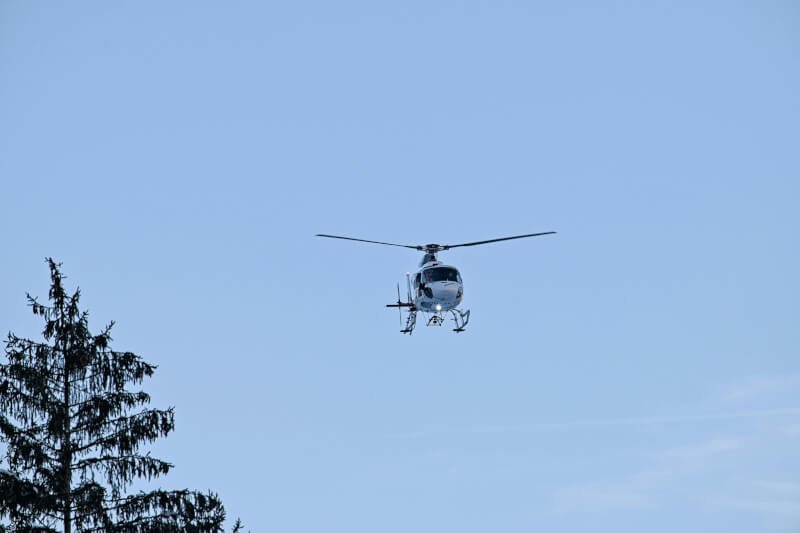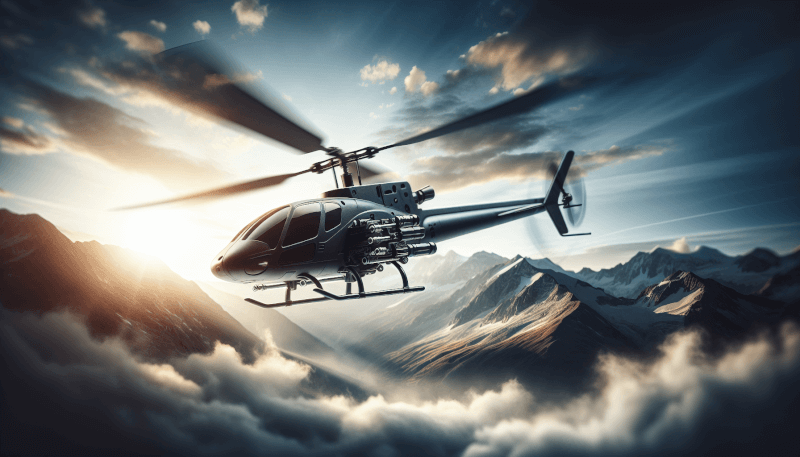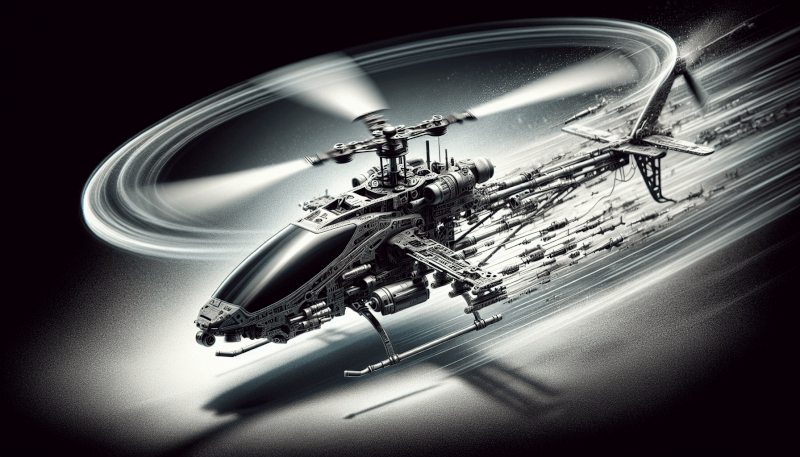Ready to take your RC heli flying to the next level? Look no further! In this article, we will provide you with the top tips for optimizing your RC heli’s flight path. Whether you’re a seasoned pilot or just starting out, these tips will help you achieve smoother flights, better control, and ultimately more satisfaction from your remote-controlled helicopter experience. So strap in, adjust your rotor blades, and get ready to soar to new heights!
Understanding Flight Dynamics
Flying an RC helicopter can be a thrilling experience, but it’s important to have a basic understanding of flight dynamics to ensure a smooth and controlled flight. One crucial aspect of flight dynamics is weight distribution. The way you distribute the weight of your helicopter can significantly affect its performance.
The center of gravity (CG) plays a vital role in flight dynamics. It represents the point at which the helicopter’s weight is balanced. To achieve optimal flight, it’s essential to have the CG positioned correctly. Improper CG placement can lead to instability and difficulties in controlling the helicopter.
Control surfaces are another critical element of flight dynamics. These surfaces, such as the main rotor blades and tail rotor, allow you to control the helicopter’s movement. By manipulating the control surfaces, you can adjust the pitch, roll, and yaw of the helicopter to maintain stability and achieve specific flight maneuvers.
Different flight modes are available for RC helicopters, each serving a specific purpose. Understanding and utilizing these flight modes can enhance your flying experience. From stability mode for beginners to acrobatic mode for advanced pilots, selecting the appropriate flight mode for your skill level and desired flight path is crucial.
Choosing the Right Rotor Blades
When it comes to optimizing your RC helicopter’s flight path, choosing the right rotor blades is paramount. Several factors come into play when selecting rotor blades, including blade length, material, and profile.
The length of the rotor blades can significantly impact the helicopter’s performance. Longer blades generally produce more lift, allowing for higher altitudes and faster ascents. However, longer blades can also increase the chance of blade strikes and require more power to spin. On the other hand, shorter blades provide more agility and are better suited for maneuvers requiring quick directional changes.
Blade material is another crucial consideration. Carbon fiber blades offer a great balance between strength and weight, making them a popular choice among RC helicopter enthusiasts. However, they can be more expensive than other materials. Plastic blades, while affordable, may not provide the same level of performance and durability as carbon fiber blades.
The blade profile, which refers to the shape and design of the blades, also plays a role in flight performance. A symmetrical airfoil profile offers equal lift in both positive and negative blade angles, making it suitable for aerobatic maneuvers. On the other hand, a flat-bottomed airfoil profile provides more lift at higher angles of attack, making it ideal for slow and stable hovering.

Setting Up Proper Trim
Trimming is an essential step in optimizing your RC helicopter’s flight path. Properly setting up trim ensures that the helicopter remains stable and responds accurately to control inputs.
Pitch trim controls the helicopter’s forward or backward movement. By adjusting the pitch trim, you can maintain level flight without having to continuously apply forward or backward inputs. It’s important to find the right balance to prevent the helicopter from constantly drifting forward or backward.
Roll trim, as the name suggests, affects the helicopter’s side-to-side movement. Correctly setting the roll trim allows the helicopter to fly straight and level without excessive rolling in either direction. This adjustment is crucial for maintaining stability during maneuvers such as banked turns.
Yaw trim controls the helicopter’s rotation around its vertical axis. Adjusting the yaw trim ensures that the helicopter maintains a stable heading without any unwanted rotation. This adjustment is especially important for maintaining control during hovering and other slow flight maneuvers.
Adjusting Control Sensitivity
Control sensitivity plays a major role in achieving precise control over your RC helicopter. By adjusting the control sensitivity, you can tailor the helicopter’s responsiveness to your flying style and skill level.
Exponential rate, often referred to as expo, allows you to fine-tune the control response. Increasing the expo reduces the initial sensitivity, making the control inputs smoother and more forgiving. This can be beneficial for beginner pilots who may find it challenging to make precise movements. On the other hand, decreasing the expo increases the initial sensitivity, providing quicker and more responsive control inputs, ideal for advanced pilots and aerobatic maneuvers.
Control throws determine the maximum deflection range of the control surfaces. By adjusting the control throws, you can increase or decrease the angle at which the control surfaces move, effectively changing the helicopter’s responsiveness. High control throws offer more maneuverability but may also increase the risk of instability, while low control throws provide a smoother and more stable flight.
Dual rates allow you to switch between different control sensitivity settings during flight. This feature can be particularly useful for pilots who wish to alternate between more aggressive maneuvers and smooth, controlled flight. By adjusting the dual rates, you can customize the helicopter’s responsiveness on the fly, adapting to different flight scenarios and personal preferences.

Utilizing Gyro Stabilization
Gyro stabilization systems have revolutionized RC helicopter flying, enhancing stability and control. Understanding and utilizing gyro stabilization can greatly optimize your helicopter’s flight path.
Gyro gain adjustment is a crucial aspect of utilizing gyro stabilization effectively. The gyro gain determines the sensitivity of the gyro system in correcting the helicopter’s movement. By finding the right balance, you can achieve a stable hover and precise control during various maneuvers. It’s important to test and adjust the gyro gain to suit your helicopter’s specific characteristics and your flying style.
Tail locking is another key feature of gyro stabilization. It ensures that the tail rotor holds a constant heading, preventing unwanted rotation. This is particularly important during steady hover and slow flight maneuvers where precise control is necessary. Properly setting up and utilizing the tail locking feature can significantly enhance your helicopter’s stability and reduce the effort required to maintain a steady flight path.
Heading hold is a feature commonly found in advanced gyro stabilization systems. It allows the helicopter to maintain its heading automatically, even in the presence of external disturbances such as wind. This is particularly useful during forward flight and when performing precise maneuvers that require strict heading control. By utilizing the heading hold feature, you can optimize your helicopter’s flight path and focus more on other aspects of flying.
Optimizing Power-to-Weight Ratio
The power-to-weight ratio is a critical factor in maximizing your RC helicopter’s performance and flight path. By carefully considering battery selection, motor choice, and ESC programming, you can achieve an optimal power-to-weight ratio.
Battery selection is important in achieving the desired flight characteristics. Different battery types offer varying levels of discharge rates and capacities. High discharge rate batteries can provide more power, resulting in faster climbs and more aggressive maneuvers. However, they may also have shorter flight times. Conversely, batteries with higher capacities may offer longer flight times but may not deliver the same level of power. Finding the right balance between power and flight time is key to optimizing your RC helicopter’s flight path.
Motor choice is another crucial consideration. Brushed motors are commonly found in entry-level RC helicopters and offer a balance between cost and performance. However, brushless motors provide more power and efficiency, making them ideal for advanced flying and aerobatic maneuvers. By selecting the appropriate motor for your helicopter, you can ensure that it has enough power to execute your desired flight path.
Electronic speed controller (ESC) programming plays a significant role in optimizing power delivery and efficiency. ESCs control the power output to the motor, and by adjusting the programming, you can fine-tune the throttle response and overall performance. Proper ESC programming can enhance your helicopter’s flight path by providing smoother and more precise control over power output.

Mastering Hovering Techniques
Hovering is a fundamental skill that every RC helicopter pilot should master. It serves as a foundation for more complex maneuvers and allows for precise control over the helicopter’s flight path.
Collective management is crucial for achieving and maintaining a stable hover. By adjusting the collective pitch, you can control the lift produced by the main rotor blades. Finding the right balance is key to achieving a steady hover without excessive ascent or descent. With practice, you can learn to adjust the collective pitch smoothly and maintain a consistent altitude during hover.
Cyclic control refers to the adjustments made to control the helicopter’s attitude and movement during hover. By tilting the main rotor blades forward, backward, left, or right, you can control the helicopter’s position within the hover. It’s important to make small and precise cyclic inputs to maintain a stable hover and avoid sudden movements that can cause instability.
Tail control plays a crucial role in hovering techniques, particularly in countering the torque produced by the main rotor. By adjusting the tail rotor’s pitch using the yaw control, you can counteract the torque and maintain a stable heading during hover. Proper tail control is essential for a balanced and controlled hover.
Practicing Flight Maneuvers
Once you have mastered hovering techniques, it’s time to expand your flying skills by practicing various flight maneuvers. These maneuvers not only add excitement to your flying but also allow you to explore different flight paths and push the limits of your RC helicopter.
Forward flight is one of the fundamental maneuvers that every pilot should practice. By gradually increasing the throttle and tilting the helicopter forward, you can transition from a hover into forward flight. This maneuver allows for increased speed and opens up a whole new range of aerial possibilities.
Banked turns add flair to your flight path and require precise control inputs. By smoothly tilting the helicopter and coordinating the cyclic and yaw controls, you can execute smooth and controlled banked turns. Practice is essential to achieve a consistent and well-balanced banked turn, as it requires coordination between multiple control inputs.
Inverted flight is an advanced maneuver that requires skill and confidence. By flipping the helicopter upside down and maintaining control, you can execute thrilling inverted flight maneuvers. Inverted flight adds a new dimension to your flight path and pushes your flying abilities to the next level. It is recommended to practice inverted flight in a controlled environment under the supervision of an experienced pilot.

Understanding Wind Effects
Wind can have a significant impact on your RC helicopter’s flight path. Understanding wind effects and adjusting your flying techniques accordingly is crucial for maintaining stability and control.
Flying with the wind requires some adjustment to compensate for the wind pushing the helicopter along its direction. By adding a slight tilt against the wind and adjusting the collective pitch, you can maintain a steady flight path and prevent the helicopter from being carried away. It’s important to anticipate wind changes and make subtle adjustments to your control inputs to counteract the wind’s effect.
Flying into the wind presents its own challenges. The wind’s resistance reduces the helicopter’s forward speed and requires increased power to maintain a consistent flight path. By tilting the helicopter slightly into the wind and adjusting the throttle, you can counteract the wind’s resistance and prevent the helicopter from losing altitude. It’s crucial to maintain a smooth and controlled flight to maximize efficiency and maintain stability.
Crosswind compensation is necessary when flying in windy conditions with a significant crosswind component. By making continuous cyclic adjustments and using the yaw control to align the helicopter with the wind, you can counteract the wind’s lateral force and maintain a stable flight path. Crosswind compensation requires advanced flying skills and should be practiced in a controlled environment.
Performing Routine Maintenance
To ensure your RC helicopter continues to perform optimally, routine maintenance is essential. Regularly checking for loose screws, inspecting the gear train, and cleaning and lubricating the helicopter are crucial steps in maintaining its performance and extending its lifespan.
Checking for loose screws is a simple yet effective way to prevent any unwanted vibrations or structural issues. Make it a habit to inspect all screws and fasteners before and after each flight. Tightening any loose screws will help maintain the integrity of your helicopter and prevent potential accidents.
Inspecting the gear train is important to ensure smooth and efficient power transfer. Check for any signs of wear or damage on the main gear, pinion gear, and tail gears. Lubricate the gear train regularly using appropriate lubricants to reduce friction and prolong the lifespan of the gears.
Cleaning and lubricating the helicopter is crucial for maintaining optimal performance. Use a soft brush or compressed air to remove any dirt, dust, or debris that may have accumulated on the helicopter’s components. Lubricate the moving parts, such as the main rotor bearings and tail rotor assembly, with appropriate lubricants to ensure smooth operation. Regular cleaning and lubrication will help prevent premature wear and ensure your helicopter operates at its best.
By following these top tips and understanding the various aspects of flight dynamics, rotor blade selection, trim settings, control sensitivity adjustments, gyro stabilization utilization, power-to-weight ratio optimization, mastering hovering techniques, practicing flight maneuvers, wind effect understanding, and performing routine maintenance, you can optimize your RC helicopter’s flight path and enjoy a thrilling and controlled flying experience. Happy flying!



